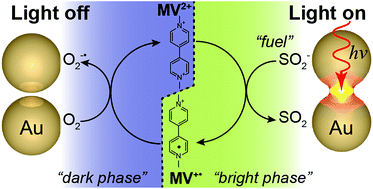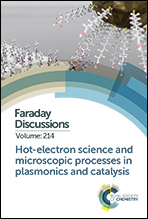Plasmon-induced optical control over dithionite-mediated chemical redox reactions
Abstract
External-stimuli controlled reversible formation of radical species is of great interest for synthetic and supramolecular chemistry, molecular machinery, as well as emerging technologies ranging from (photo)catalysis and photovoltaics to nanomedicine. Here we show a novel hybrid colloidal system for light-driven reversible reduction of chemical species that, on their own, do not respond to light. This is achieved by the unique combination of photo-sensitive plasmonic aggregates and temperature-responsive inorganic species generating radicals that can be finally accepted and stabilised by non-photo-responsive organic molecules. In this system Au nanoparticles (NPs) self-assembled via sub-nm precise molecular spacers (cucurbit[n]urils) interact strongly with visible light to locally accelerate the decomposition of dithionite species (S2O42−) close to the NP interfaces. This light-driven process leads to the generation of inorganic radicals whose electrons can then be reversibly picked up by small organic acceptors, such as the methyl viologen molecules (MV2+) used here. During light-triggered plasmon- and heat-assisted generation of radicals, the S2O42− species work as a chemical ‘fuel’ linking photo-induced processes at the NP interfaces with redox chemistry in the surrounding water environment. By incorporating MV2+ as a Raman-active reporter molecule, the resulting optically-controlled redox processes can be followed in real-time.

- This article is part of the themed collection: Hot-electron science and microscopic processes in plasmonics and catalysis


 Please wait while we load your content...
Please wait while we load your content...